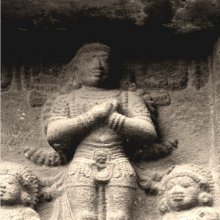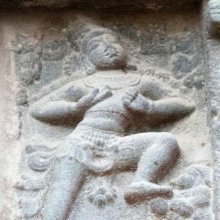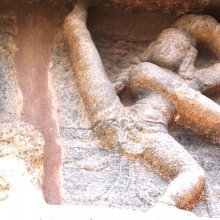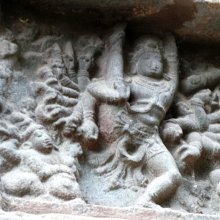Avidha, Avidhā, Āvidha: 8 definitions
Introduction:
Avidha means something in Hinduism, Sanskrit. If you want to know the exact meaning, history, etymology or English translation of this term then check out the descriptions on this page. Add your comment or reference to a book if you want to contribute to this summary article.
Images (photo gallery)
Languages of India and abroad
Sanskrit dictionary
Source: DDSA: The practical Sanskrit-English dictionaryAvidhā (अविधा).—ind. An interjection meaning 'help, help' used in calling for help in danger. cf. Pratijnā.3.
--- OR ---
Āvidha (आविध).—See under आव्यध् (āvyadh).
See also (synonyms): āviddha.
--- OR ---
Āvidha (आविध).—[ā-vyadh-ghañarthe-ka] An awl; drill.
Derivable forms: āvidhaḥ (आविधः).
Source: Cologne Digital Sanskrit Dictionaries: Edgerton Buddhist Hybrid Sanskrit DictionaryAvidhā (अविधा) or Avidhaṃ.—interj. (always repeated; most often followed by (i)ti; = Prakrit avihā, compare avidā, avida, exclamation of sorrow, Sheth), exclamation of disapproval or dismay; only noted in Mahāvastu; mss. sometimes abhi-for avi-, occasionally -dhāṃ for -dhaṃ or -dhā: avidhā avidhā ii.450.5; avidhāvidhaṃ (ti; so mss.) ii.450.7; avidhāvidhā (usually followed by ti) i.301.19; iii.73.17; 86.16; °dhāṃ (mss.) ii.452.11; °dheti i.303.21 (mss.); °dhaṃ or °dhan (ti) i.301.20; 302.1; 303.19; ii.452.8 (mss.); 462.15; iii.15.15; 189.10, 11. Rarely ā-is written in mss. for initial a-.
Source: Cologne Digital Sanskrit Dictionaries: Shabda-Sagara Sanskrit-English DictionaryĀvidha (आविध).—m.
(-dhaḥ) An awl, a drill, a kind of gimblet worked by a string. E. āṅ before vyadha to pierce, ghañ or ka aff.
Source: Cologne Digital Sanskrit Dictionaries: Monier-Williams Sanskrit-English Dictionary1) Avidhā (अविधा):—ind. an interjection (said to correspond to the Prākṛt avihā, or aviha, used in calling for help) [commentator or commentary] on [Śakuntalā]
2) Āvidha (आविध):—[=ā-vidha] [from ā-vyadh] m. an awl, a drill
3) [v.s. ...] a kind of gimlet worked by a string, [cf. Lexicographers, esp. such as amarasiṃha, halāyudha, hemacandra, etc.]
Source: Cologne Digital Sanskrit Dictionaries: Yates Sanskrit-English DictionaryĀvidha (आविध):—[ā-vidha] (dhaḥ) 1. m. An awl.
[Sanskrit to German]
Sanskrit, also spelled संस्कृतम् (saṃskṛtam), is an ancient language of India commonly seen as the grandmother of the Indo-European language family (even English!). Closely allied with Prakrit and Pali, Sanskrit is more exhaustive in both grammar and terms and has the most extensive collection of literature in the world, greatly surpassing its sister-languages Greek and Latin.
Kannada-English dictionary
Source: Alar: Kannada-English corpusAvidhā (ಅವಿಧಾ):—[interjection] a cry for help in danger.
Kannada is a Dravidian language (as opposed to the Indo-European language family) mainly spoken in the southwestern region of India.
See also (Relevant definitions)
Starts with: A-vitam, Avidhakarni, Avidham, Avidhana, Avidhanatas, Avidhanavami, Avidhava, Avidhavanavami, Avidhaya, Avidhayaka, Avidhayin, Avita.
Ends with (+47): Amavasyavidha, Anadavidha, Anamtavidha, Anekavidha, Aparimitavidha, Apavidha, Arkavidha, Asaptavidha, Ashtavidha, Atthavidha, Avavidha, Avita, Bamdhavida, Bhadravidha, Caitayatavidha, Caturdashavidha, Caupayatavidha, Citravidha, Dasavidha, Dvadashavidha.
Full-text: Avide, Avidho, Vyavidha, Mrigavidha, Avidham, Avita, Apita, Prativeshaka, A-vitam, Aviddha, Vata.
Relevant text
Search found 3 books and stories containing Avidha, A-vidha, Ā-vidha, Avidhā, Āvidha; (plurals include: Avidhas, vidhas, Avidhās, Āvidhas). You can also click to the full overview containing English textual excerpts. Below are direct links for the most relevant articles:
The Mahavastu (great story) (by J. J. Jones)
Chapter XXX - The story of Mālinī < [Volume I]
Chapter XIX - The Jātaka of Gaṅgapāla < [Volume III]
Chapter IX(a) - The Five Hundred Merchants (prose) < [Volume III]
Mudrarakshasa (literary study) (by Antara Chakravarty)
2. The theory of rīti < [Chapter 5 - Adoption of Style and Language in Mudrārākṣasa]
The Shiva Purana (by J. L. Shastri)
Chapter 15 - The manifestation of Rudra < [Section 2.1 - Rudra-saṃhitā (1): Sṛśṭi-khaṇḍa]



